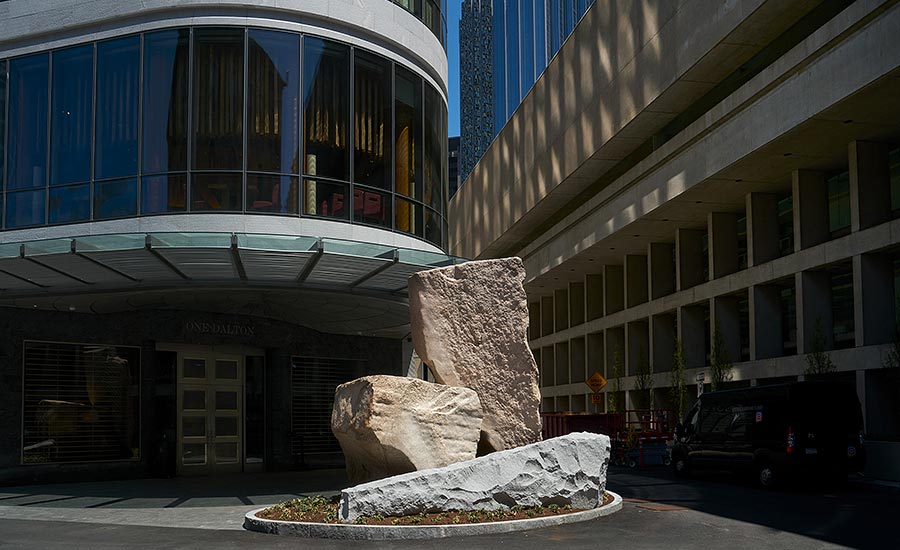Four Seasons Hotel & Private Residences, One Dalton Street is among the newest buildings enhancing Boston’s skyline. Standing 61 stories high, the tower -- featuring an urban chic design -- is the city’s third tallest building and the tallest residential building in New England. Taking center stage of the urban landscape located at the entrance of the residential building is “Event,” a stone sculpture crafted by sculptor Darrell Petit of Darrell Petit LLC and Stony Creek Quarry Inc. Petit was commissioned by landscape architecture firm Michael Van Valkenburgh Associates (MVVA) of Cambridge, MA. The building design was the creation of Pei Cobb Freed & Partners of New York, NY.
“Event” -- comprised of two Stony Creek granite elements of a combined weight of 50 tons joined in dynamic connection of interdependence and grounded by a third 12-ton interloping element of Barre Grey granite – measures 15 feet, 6 inches high x 12 feet wide x 16 feet long.
Discussing “Event” a 60-ton granite sculpture with Darrell Petit

Darrell Petit discusses “Event” a 60-ton granite sculpture at the entrance to a Four Seasons Hotel and Private Residences in Boston, MA, as well as the sustainability of natural stone
Petit explained that the sculpture’s configuration enables a multiplicity of views from all angles and perspectives of the site. “A physical tension becomes manifest as one experiences the enormous forces that are in balance with each other,” he said. “A viewer might be led to personify the stones by taking the point of view of each coming to the conclusion that the stones represent the dynamic of a human partnership.”
“The overall approach to the landscape focused on its appeal and usefulness to the people who would use it in their every-day lives,” said Laura Solano, partner at MVVA. “The landscape stands on its own, making it unnecessary to respond to the large scale of One Dalton. Boston is architecturally traditional and the adjacent 19th Century townhouses echo that, but the 1970s era Christian Science Center’s administrative offices are in the style of Brutalist architecture, and the new Four Seasons/One Dalton’s tower is sleek and taught. In this case, the landscape was used to unify design eras, to be the meeting ground between residents, workers and hotel visitors, and to add more greenspace to this part of the town.”
“Event” is sited where pedestrians and vehicles overlap; it is experienced differently from every approach, according to Petit. “Topography plays a subtle but important role in defining and differentiating its spatial envelope by elevating it 18 inches above the surrounding grade, which reinforces its monumentality,” he said. “This soft mound within the planter is approximately 28 feet long x 15 feet, 6 inches wide. It was also just enough to mask the sculpture’s foundation and to increase soil volume for plants.
“The monumentality, bold forms and surface textures of “Event” called for a quiet and consistent treatment at its base,” Petit went on to say. “Plants offered a complementary, but unassuming solution. Monroe’s White Lily Turf (Liriope muscari ‘Monroe’s White) forms an evergreen mat at the base of Event and was selected for its strap-like, arching, dark leaves and tolerance of urban conditions. It grows to about 12 to 18 inches tall in tiered whorls with subtle white flowers in late summer.”
“’Event has become an iconic form in the project,” said Solano. “Although it was conceived to serve the residential entry, the sculpture is visible from every direction. It catches the eye from near and far, changing with light, season and aspect. Although it is not a landscape in a traditional sense, its quiet complexity shares all the best aspects of nature.”















